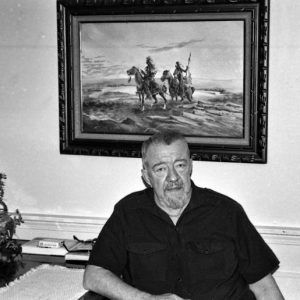calsfoundation@cals.org
Douglas Clyde Jones (1924–1998)
“Slowly, but with infinite grace,” the Washington Post once enthused of Fayetteville (Washington County) author Douglas Clyde Jones, “[he] is creating a masterful fictional history of America.” Over the course of three decades, Jones, a career military officer turned award-winning novelist, wrote more than a dozen books—including his bestselling The Court-Martial of George Armstrong Custer (1976)—that dealt with everything from the American Revolution and the opening of the Western frontier to the Spanish-American War, assorted Native American conflicts, and the Great Depression. His tales, most of which were either set in Arkansas or featured Arkansan protagonists, were spirited and sprawling, his historical backdrops vividly portrayed, and his characters brutal or benevolent in measures consistent with their times and circumstances.
Born in Winslow (Washington County) on December 6, 1924, Douglas C. Jones was the only son of auto mechanic Marvin Clyde Jones and Bethel Stockburger Jones. Following moves to Fort Smith (Sebastian County) and then to Kansas City, Missouri, Jones’s parents divorced when he was twelve, and he and his two sisters went to live with their mother in her hometown of Fayetteville. He graduated from Fayetteville High School in 1942 and was drafted into the U.S. Army, serving in the Pacific during World War II and finally being stationed at Okinawa, Japan. After the war, he returned to Fayetteville, where he attended the University of Arkansas (UA) in Fayetteville (UA) from 1945 to 1949, graduating with a bachelor’s degree in journalism. While still a student at the university, he met his future wife, Mary Alice Arnold. They were married in the early morning hours of New Year’s Day, 1949, after Jones—who played standup bass in a jazz band—finished performing at a party in Eureka Springs (Carroll County). The couple eventually had three daughters and a son.
Following graduation, Jones went back into the army. Over the next two decades, he was stationed in a variety of locales, including Germany; Fort Benning, Georgia; the Korean Demilitarized Zone (DMZ); and, in the early 1960s, Madison, Wisconsin. In Madison, he earned a master’s degree in the history of mass communications from the University of Wisconsin (1962–1964). His master’s thesis—focusing on 1867 treaties establishing reservations for the Kiowa, Comanche, Plains Apache, Cheyenne, and Arapaho Indian tribes—later became his first published book, The Treaty of Medicine Lodge (1966). Meanwhile, Jones was transferred to Washington DC, where he worked at the Pentagon as public information officer for the Department of Defense. But in the summer of 1968, after being promoted to the rank of lieutenant colonel, and with U.S. public support for the Vietnam War waning, Jones resigned his commission and began teaching journalism at the University of Wisconsin. He stayed on there for six years (1968–1974), not only teaching but also developing his talents as an artist. (His paintings and drawings focused on Native American and Western subjects.) For some time, Jones had also been brewing an idea for a novel, speculating on what might have happened to Lieutenant Colonel George Armstrong Custer had he survived Montana’s 1876 Battle of the Little Bighorn. But it was not until Jones’s last summer in Madison, just prior to his returning to Fayetteville, that he was put in contact with a New York literary agent. He spent most of the next two years composing The Court-Martial of George Armstrong Custer, which was adapted into a 1976 TV movie starring James Olson and Brian Keith.
That success led Jones to pen a string of historical novels. Several—including Arrest Sitting Bull (1977) and Remember Santiago (1988)—fictionalized actual events. Others, such as This Savage Race (1993) and Shadow of the Moon (1995), followed generations of characters determined to tame the West. In addition, Jones authored tales sympathetic to Indian conflicts with white settlers, among them Season of Yellow Leaf (1983) and Gone the Dreams and Dancing (1984); frontier mysteries, including The Search for Temperance Moon (1991) and A Spider for Loco Shoat (1997); and a trilogy that followed Roman Hasford, a deeply scarred child of the Civil War, from the Ozarks through the latter half of the nineteenth century—Elkhorn Tavern (1980), Roman (1986), and Come Winter (1989). Jones’s single short-story collection is Hickory Cured (1987). He also wrote the novels A Creek Called Wounded Knee (1978), Winding Stair (1979), Weedy Rough (1981), and The Barefoot Brigade (1982). His work won him three Golden Spur Awards from the Western Writers of America and, in 1993, that association’s Owen Wister Lifetime Achievement Award.
A lifelong smoker, Jones died at his Fayetteville home on August 30, 1998, from chronic obstructive pulmonary disease (COPD). He was cremated, and his ashes were sprinkled over northern Arkansas’s Boston Mountains. His seventeenth novel, Sometimes There Were Heroes, which dramatizes early Texas history, was published posthumously in 2000.
For additional information:
Caillouet, Linda S. “Douglas C. Jones Old West Author, 73, Grew Up Fascinated by Tales of Frontiers.” Arkansas Democrat-Gazette, September 1, 1998, p. 4B
Mitgang, Herbert. “Books of the Times: Defining the Western, and Two Current Examples.” New York Times, December 2, 1989, p. 19.
J. Kingston Pierce
January Magazine



 Douglas Jones
Douglas Jones 



I just read The Barefoot Brigade–one of the best, maybe the best, Civil War novel of all time. Hope everyone can get a copy and see what a tremendous writer Mr. Jones was.